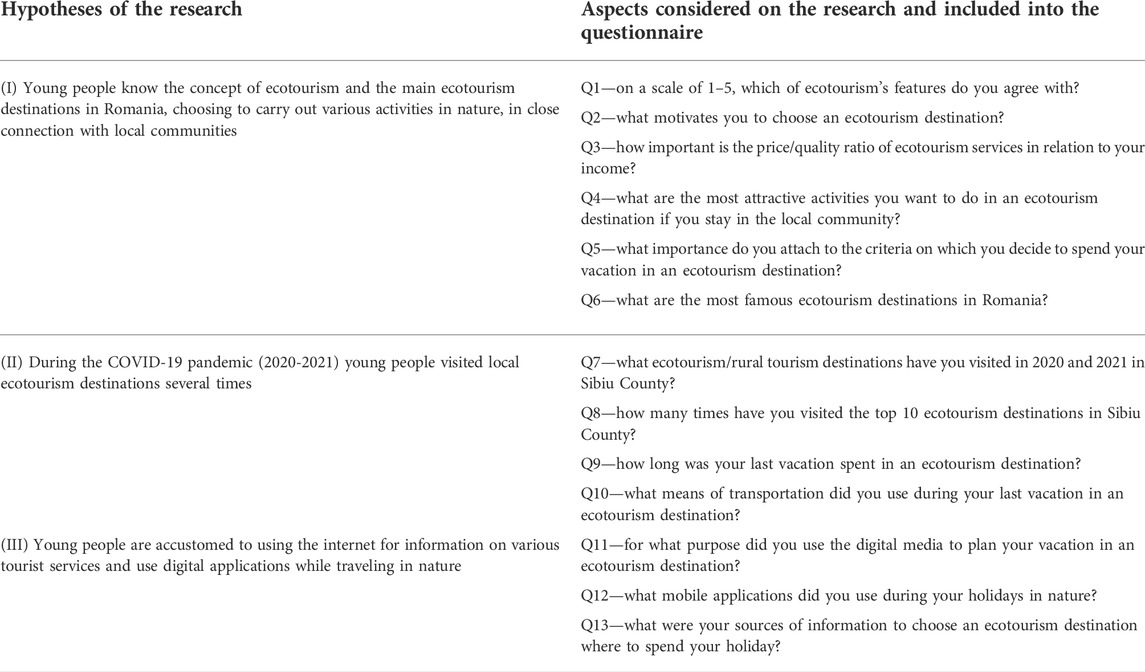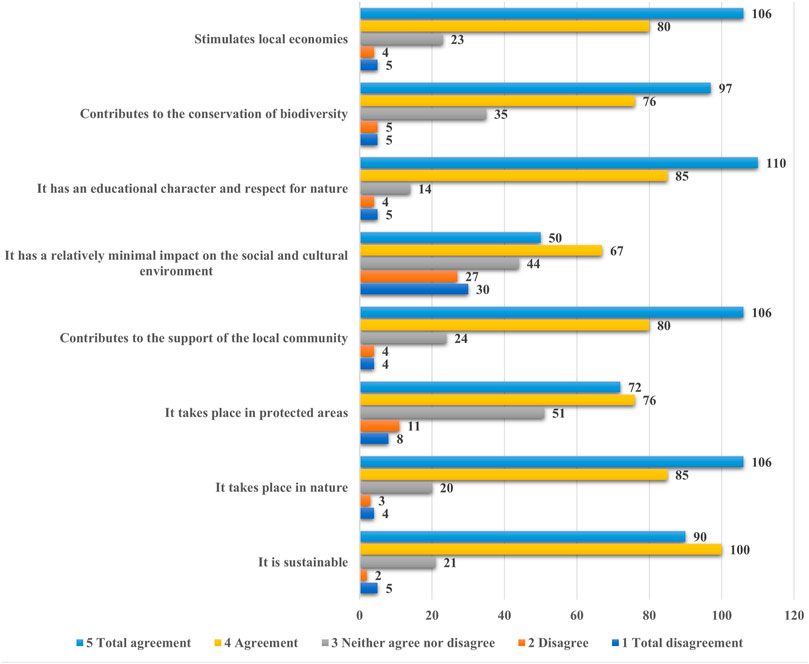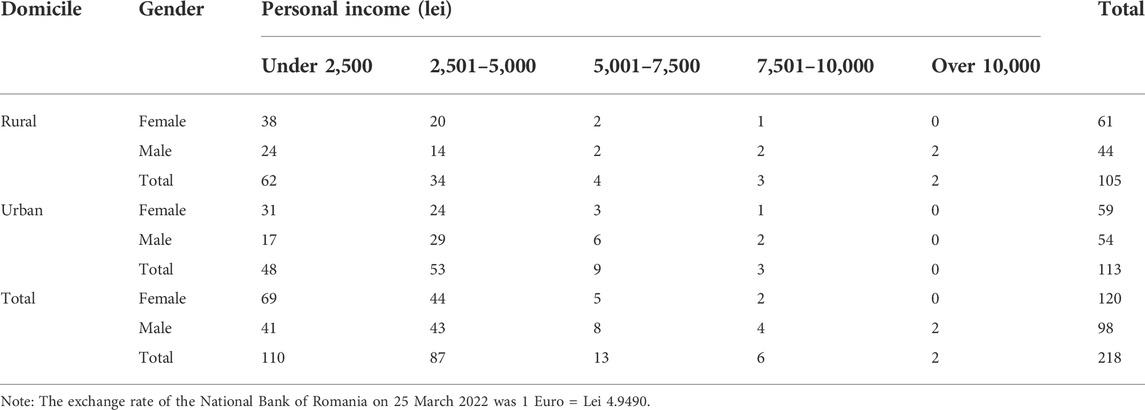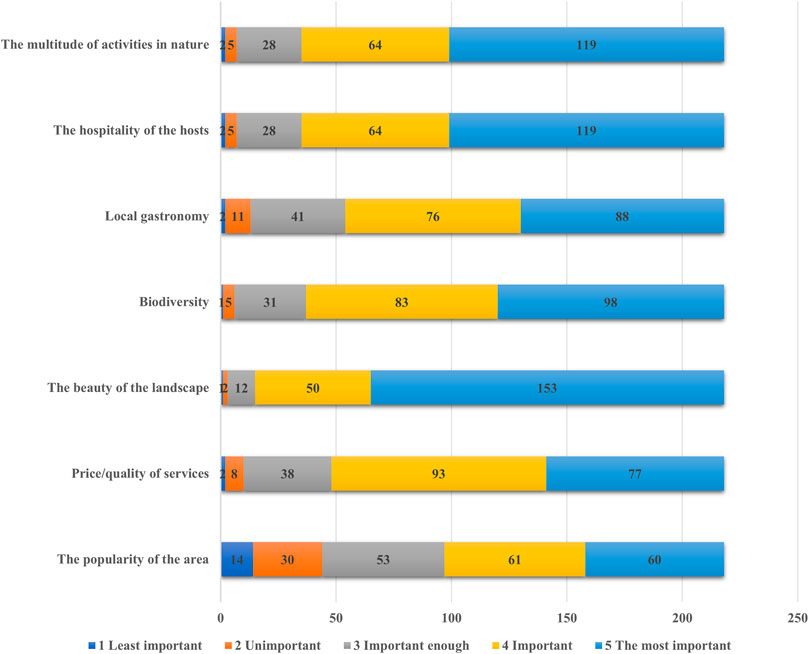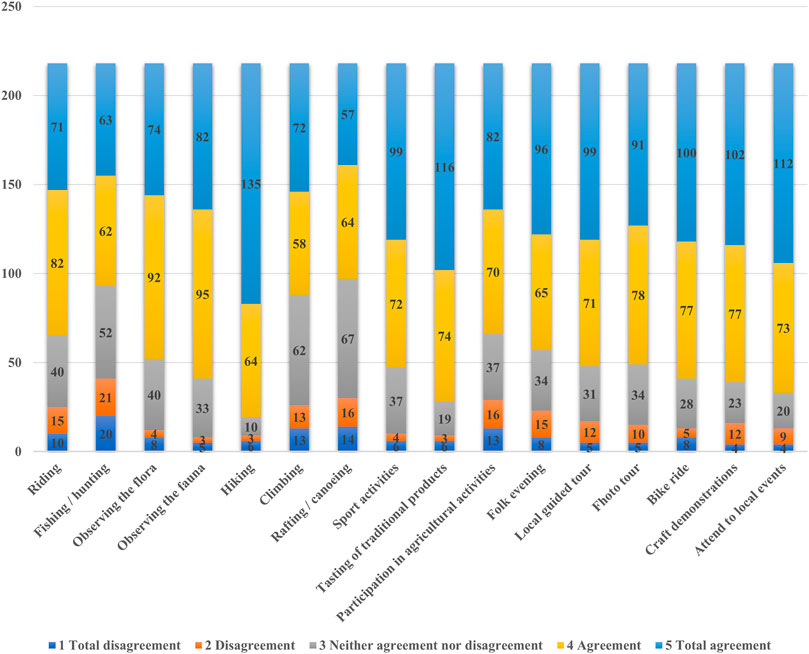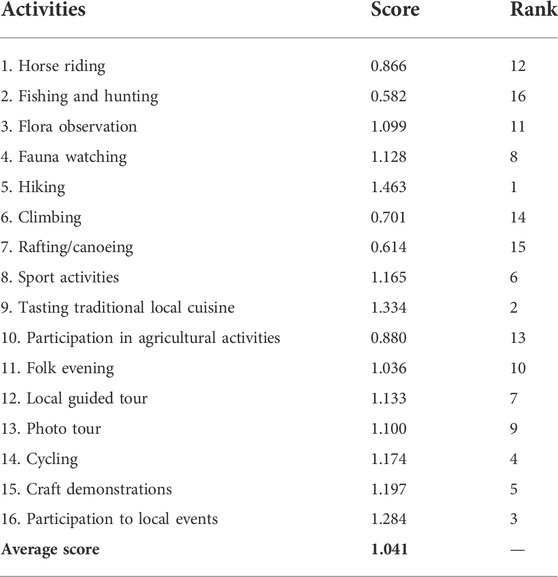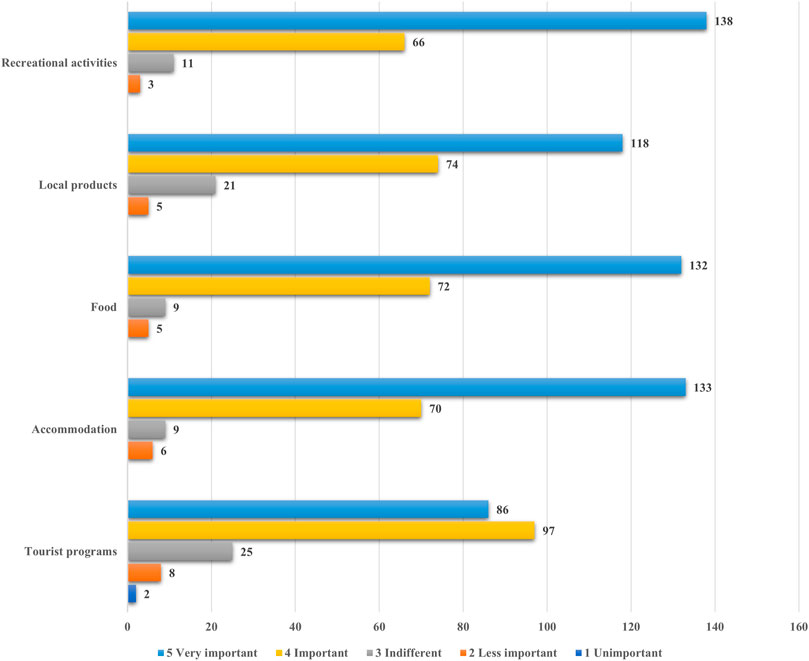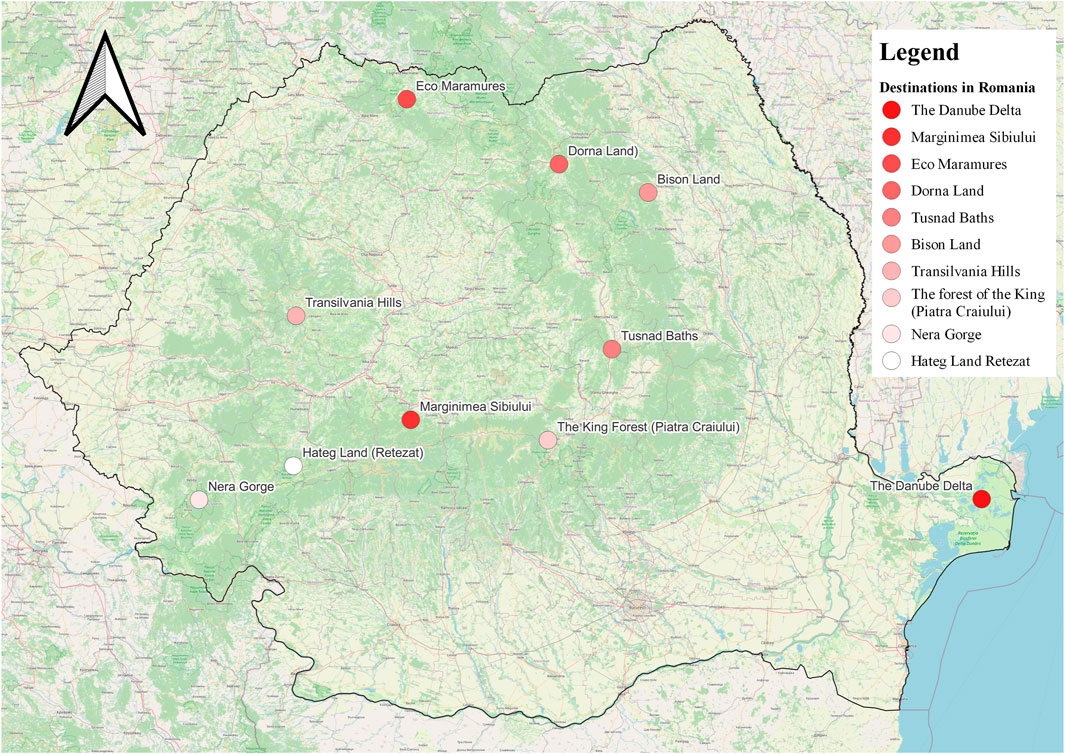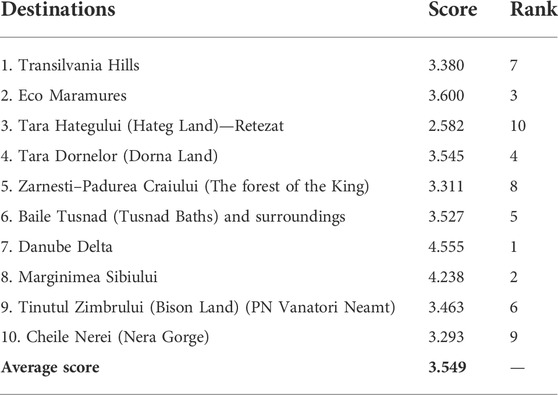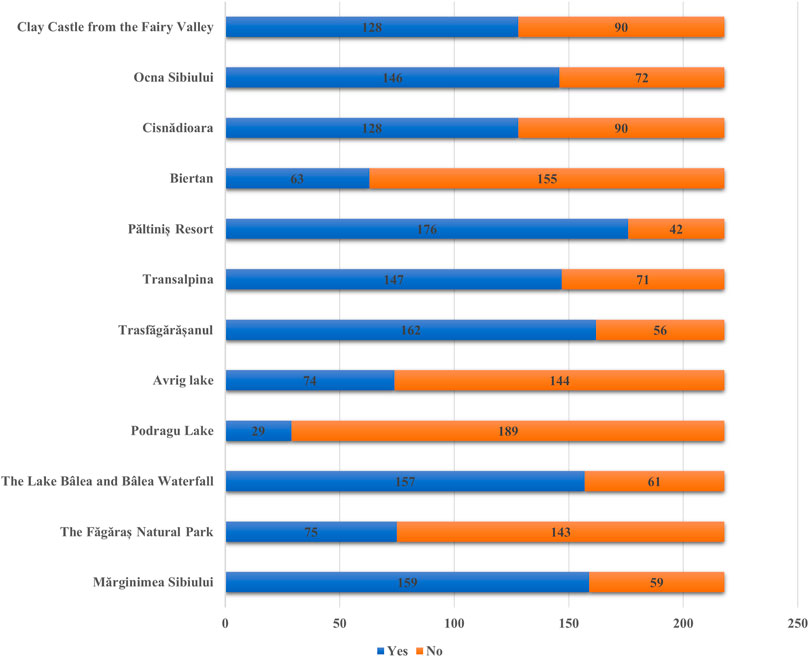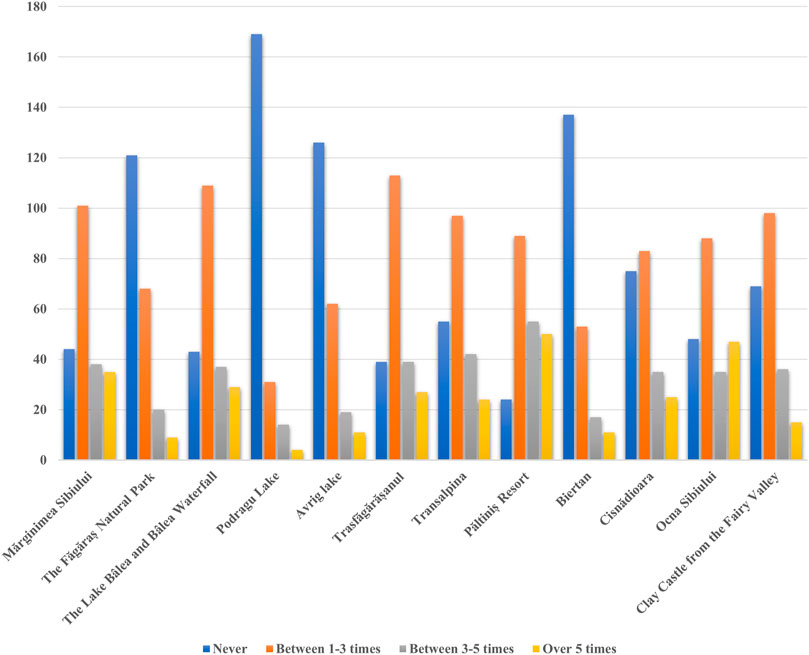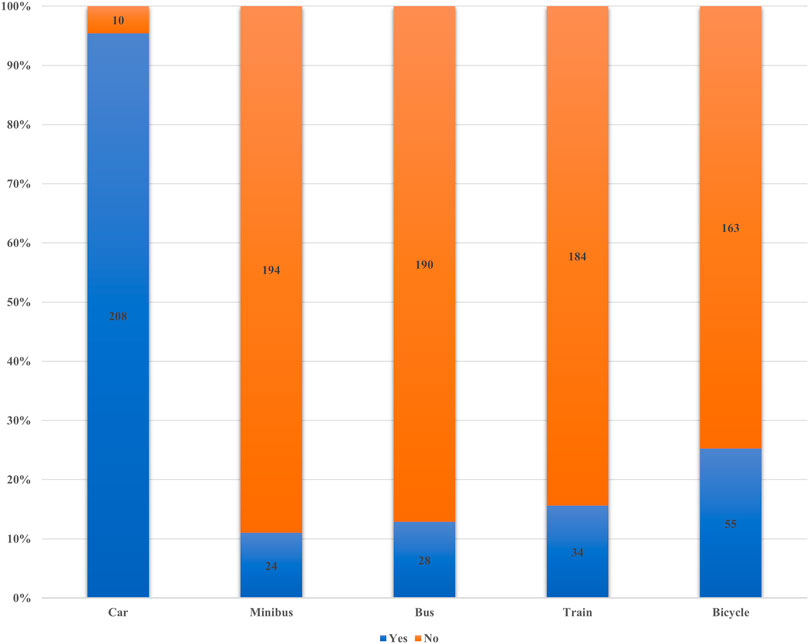- 1Department of Agricultural Sciences and Food Engineering, “Lucian Blaga” University of Sibiu, Sibiu, Romania
- 2Faculty of Management and Rural Development, University of Agronomic Sciences and Veterinary Medicine Bucharest, Bucharest, Romania
- 3Faculty of Business Administration in Foreign Languages, Bucharest University of Economic Studies, Bucharest, Romania
- 4Faculty of Social Sciences, Jan Długosz University in Częstochowa, Częstochowa, Poland
The knowledge, perception, and behavior of young people toward ecotourism are important for the sustainable development of this sector. The purpose of this research is to evaluate and analyze the knowledge of young Romanian students about ecotourism and the main ecotourism destinations in Romania, their behavior in relation to the practice of this form of sustainable tourism at the local level in the last 2 years (2020 and 2021), and people’s use of the Internet for planning holidays and digital applications while traveling in nature. A quantitative research was conducted based on a self-administered questionnaire, structured in 13 sections on ecotourism, to which were added the sociodemographic data of the respondents. The conclusions of the research are that young people know well the main ecotourism destinations in Romania; they choose them according to the beauty of the landscape, multitude of outdoor activities, and the hospitality of the hosts. In the last 2 years of the pandemic, young people have visited several times the main existing ecotourism destinations locally, with an average vacation duration of 1–3 days. The Internet remains the main source of information, and in the field, they use mobile applications that allow the download of digital maps and recognize different plant species. By integrating various activities in nature, in close connection with the local culture, ecotourism can contribute to the sustainable use of local tourism resources. This study provides a detailed and realistic picture of the knowledge and the type of ecotourism experience that young people want. The implications are theoretical and managerial, highlighting the importance of assessing the preferences of young ecotourists, as a basis for developing ecotourism strategies, sustainable use of local tourism resources, and management of protected areas.
1 Introduction
1.1 General theoretical framework
Climate change and the COVID-19 pandemic are major challenges that have caused and continue to cause changes in human behavior in search of solutions to restore the balance between people and nature (Vidickienė et al., 2021). In this context, we are witnessing changes in consumption patterns and lifestyles today. Ecotourism is one of the most popular forms of sustainable tourism and also a model of responsible consumption; the habits and behavior of ecotourists are being influenced mainly by education, knowledge and awareness, love for nature, and the desire for new experiences beneficial to health (Negacz, 2021). Research on the innovative transformation of tourism also refers to “regenerative tourism” (Scheyvens et al., 2021), which is not only environmentally friendly but also constructive giving it a better state, expressing the desire of people to preserve nature.
Current trends and characteristics of world tourism include the use of modern online technologies for information and purchasing of tourism products and services; increasing the number of trips and shortening the length of stay to 2–4 days; the request for personalized tourist offers through travel agencies; increasing the share of senior tourists looking for new experiences for a healthy and active life, with an increased interest in outdoor activities and wellness; increasing the share of single travel, especially among women; increasing the share of young hikers eager to broaden their horizons of knowledge in search of new cultural, historical, and nature experiences; increasing the demand for accommodation and leisure offers specialized in ecotourism; increasing the demand for the quality of tourist services and their level of comfort and diversity; and orientation toward safe, hospitable destinations and in areas away from large urban agglomerations. Ecotourism is defined by the International Society for Ecotourism (TIES) as “a responsible travel in natural areas that preserves the environment and supports local communities, involving interpretation and education” (What Is Ecotourism, 2022) and responds to current trends. Ecotourism offers the opportunity to know the nature and local culture; applies the principles of sustainable tourism in social, economic, and environmental terms; and emphasizes education and respect for nature (Pleșoianu et al., 2018), contributing to sustainable regional development (Pavlidis et al., 2022a). According to the World Tourism Organization (UNTWO) definition, ecotourism includes “all forms of nature-based tourism, in which the main activities refer to the observation of it and the local culture in the immediate vicinity of the protected areas; educational and nature interpretation activities; activities with minimal negative impact on the natural and sociocultural environment, carried out in small groups; and activities that support the conservation of biodiversity and the well-being of local communities” (World Tourism Organization Ecotourism and Protected Areas, 2022). A recent World Tourism Organization publication highlighted the need to improve accessibility in protected areas by supporting the competitiveness and sustainability of tourist destinations, changing visitor attitudes, and integrating environmental intelligence into tourism (AmI) through smart innovations and digital technology (World Tourism Organization Accessibility and, 2021). Ecotourism is an alternative form of tourism that takes place in protected areas (Mateoc-Sîrb et al., 2022) and implies a bilateral relationship between nature and tourism services (Remus et al., 2009). Interdisciplinary research in the field of ecotourism has developed a lot in recent years, with its evolution addressing various levels: human disturbance of nature, ecosystem services, and sustainable development (Coghlan and Carter, 2020).
1.2 Literature review
Ecotourism as part of sustainable tourism offers tourists a unique experience, contributes to the well-being of local communities, conservation of natural resources, and the preservation of local culture, while achieving a balance between the needs of tourists and the local community. Through the activities proposed by ecotourism, it involves the direct interaction of visitors to a protected area with its natural habitats, providing social and cultural services, and also contributing to the physical and mental health of tourists (Li et al., 2022).
A World Tourism Organization report shows that young people in their travels want unique experiences, prefer rural or suburban areas, are willing to “live like a local”, and want to have direct contact with local culture and residents (World Tourism Organization Affiliate Members Global Report, 2016). The attitude and behavior of young people toward tourism are important for the sustainable development of this sector (Bilan et al., 2020). Recent studies conducted in different countries show that, in general, young people have a behavior oriented toward sustainability (Cioca and Bratu, 2020), and their attitude supports the well-being of the areas visited in the long term (Šaparnienė et al., 2022).
Romania benefits from an increased potential for ecotourism due to the following: the existence of the Carpathian Mountains on 31.9% of the country’s surface (Mountain Green Cover Index = 96.8) (Alfthan et al., 2018) and over 70% of Europe’s virgin forests; the presence of the Danube Delta—an objective inscribed on the UNESCO list; high value natural landscapes; specific local architecture; and traditions, customs, gastronomy, and authenticity in rural areas. Despite all these resources, in 2019 the contribution of tourism to the Gross Domestic Product of Romania was 5.3%, and during the pandemic 2020 and 2021, it was lower. In the 2 years of pandemic, tourists who visited Romania preferred rural pensions and agritourism pensions (Popescu and Plesoianu, 2021) for the security offered, lower risk of infection, quality of services, and convenient prices. At the same time, the implementation of the National Ecotourism Strategy (Celac and Vădineanu, 2018) will contribute to the integration of ecotourism and rural tourism into the “green economy” and “green marketing” (Nistoreanu et al., 2020; Dragomir and Mazilu, 2021), although in Romania there is no regulation in national legislation to make the “green labeling” of tourist structures with accommodation function (Mitrică et al., 2021). The green tourism economy involves the selection of environmentally responsible accommodation facilities, which pay special attention to “green” purchases, “green” labeling, and the responsible economy (Trišić et al., 2021). Businesses that adopt green trends and integrate them into their own strategies are more likely to survive in the marketplace in the future (Buric et al., 2022).
In the current context of the COVID-19 pandemic (Halbusi et al., 2022), studies are needed at the international, national, and local level to understand the attitudes and intentions of tourists in general and young tourists in particular (Wojcieszak-Zbierska et al., 2020). Few studies on ecotourism have been published in Romania in general, and in the current period, their number is even lower.
The aim of the study is to identify student’s perception of ecotourism as a possible model for the sustainable use of local tourism resources. The study has three objectives: 1) evaluation and analysis of the knowledge of young Romanian students about ecotourism and the main ecotourism destinations in Romania; 2) analysis of the behavior of young people regarding the practice of this form of sustainable tourism at the local level in the last 2 years (2020 and 2021); and 3) analysis of young people’s use of the Internet for information, vacation planning, and digital applications while traveling in nature. The study has theoretical and scientific importance, but especially practical-managerial for improving the strategy of ecotourism development in Romania and the sustainable use of local tourism resources.
The study is presented in a sequential logical structure that includes four sections: Introduction, which presents the context of this study and the literature review, regarding the profile of visitors from ecotourism destinations; the Materials and Methods section in which the working methodology is described; the Results and Discussions section presents the stage of development of ecotourism in Romania and the main findings of the research; and Conclusion summarizes the study and presents recommendations addressed to tourism entrepreneurs, protected area management and local public administrations in the area of protected areas, study limitations, and future research directions.
The scientific literature shows that higher education institutions through their multiple functions (research, education, and societal impact) are increasingly recognized for their potential to contribute to the necessary transformation of society toward sustainability (Bratu and Ionel Cioca, 2019; Cioca and Bratu, 2021; Probst, 2022). According to Popescu et al. (2022), the ecotourism is a form of tourism with rural character which involves the use of local natural resources through tourism activities, with multiple benefits for communities bordering protected areas.
Weaver shows that a typical ecotourist comes from a developed country, is a woman with higher education and high income, and has a generally higher average age (The Encyclopedia of Ecotourism and Weaver, 2000). Another author classifies ecotourists into two categories: hard ecotourist, who is interested in real experiences in the middle of nature; soft ecotourist, who wants a superficial contact with natural attractions (Gibson et al., 2003). A study conducted by Buffa et al. (2015) in Italy among 1,156 young people between the ages of 19 and 29 analyzed their motivation to travel, their behavior during the trip, and their sensitivity to sustainability. The results obtained statistically confirmed two major categories: hard ecotourists and soft ecotourists.
A previous research has highlighted the association of environmental effects, new product development performance, superior customers’ value, and corporate social responsibility on sustainable performance, under the impact of the COVID-19 pandemic (Abbas et al., 2019a; Aman et al., 2021; Fu et al., 2021; Yu et al., 2022). Corporate social responsibility, innovation, social media, and internet use are affecting not only business performance but also the mental health of people and the well-being (Abbas et al., 2021; Mubeen et al., 2021a; Hussain et al., 2021; Li et al., 2021), with major impact on tourism.
The literature has outlined a profile of visitors from Romanian ecotourism destinations, which shows that the ecotourist is a person aged 30–50 years, with higher education and average income (Constantin et al., 2021). A study presents four categories of visitors to ecotourism destinations in Romania: travelers interested in nature; travelers interested in culture; agreement-interested travelers, and eclectic travelers (Petris et al., 2022). Another study conducted among 300 respondents grouped ecotourists into four categories (hardcore ecotourists, ecotourist “tables,” occasional ecotourists, and dedicated ecotourists), depending on their behavior and motivation, being more concerned about the environment, and more active than regular tourists (Crețu et al., 2020).
The study is an original research work based on testing a group of young people studying disciplines related to rural tourism, agrotourism, and ecotourism, mostly B. Sc. and M. Sc. students of the Faculty of Agricultural Sciences, Food Industry and Environmental Protection, “Lucian Blaga” University, Sibiu, Romania.
The aim of the study is to provide a perspective on the following: the knowledge and perception of students in a faculty of agricultural profile and environmental protection regarding the ecotourism and the main ecotourism destinations in Romania; their behavior in visiting local ecotourism destinations in the last 2 years; and young people’s use of the internet for holiday planning and digital applications during nature trips.
The hypotheses of the research are as follows:
(1) Young people know the concept of ecotourism and the main ecotourism destinations in Romania and choose to carry out various activities in nature, in close connection with local communities
(2) During the COVID-19 pandemic (2020–2021) young people visited local ecotourism destinations several times
(3) Young people are accustomed to using the Internet for information on various tourist services and use digital applications while traveling in nature
The study provides a theoretical basis for the needs of a target group of young people, which can be used to determine tourism policies at the national level. At the same time, the study brings to the attention of the stakeholders of interests regarding ecotourism on the tourist destinations preferred by young people, at the national level.
2 Materials and methods
To assess how tourism is appreciated by young people to spend their holidays in nature, protecting ecosystems, and supporting rural communities economically, socially, and culturally, a structured questionnaire has been developed and used (Emile Durkheim, 1857–1917) (Durkheim, 2008), which is well known as a method of quantitative research specific to marketing but also to the social survey.
Table 1 presents the research hypotheses and the main aspects considered in it, based on which the questionnaire was developed, which comprises 13 sections.
The questionnaire also included questions to classify respondents by age, gender, domicile, county of origin, and average monthly gross income level.
The size of the sample subjected to the test was determined with the formula belonging to Cochran (1977) (p.75),
in its corrected variant
where Z2 is the abscise of the tails for 95% confidence level (1- ɑ); Z value is 1.96 according to the Gauss–Laplace Table for P95%; “p” is the estimate of proportion of an attribute; “q” is 1-p; “e” is the precision level (0.05); and N = 470 individuals representing the number of B. Sc. and M. Sc. students enrolled at the faculty (Bartlett et al., 2001).
Therefore, the sample size comprised 218 respondents, who received the questionnaire on their e-mail address and had to send their answers during the interval 19 January–1 February 2022. The sample size is representative (46.3%) of the number of students enrolled at the Faculty of Agricultural Sciences, Food Industry and Environmental Protection, “Lucian Blaga” University of Sibiu.
The answers were synthesized and statistically processed using Excel, v. 365 Microsoft Corporation, Redmond, WA, United States, and SPSS Statistics, version 26 (IBM, 2022).
The frequencies and the shares of the answers for each item of each question were processed using the following:
- Semantic differential scale (Charles Egerton Osgood, 1975), which reflects the intensity of the opinions based on the weighted arithmetic mean for each item of a question, according to the following formula:
where xi is the score connected to the appreciation and fi is the frequency, more exactly the number of answers registered for each score.
Likert scale (Likert, 1932) reflects the agreement and disagreement of the respondents related to an item of a question. In the article we used both 4- and 5-Point Likert scale.
The results were illustrated in suggestive graphics and tables and have been correspondingly interpreted (Abbas et al., 2019b; Abbasi et al., 2021; Mubeen et al., 2021b; Zhang et al., 2022). Finally, the main conclusion was drawn.
3 Results and Discussion
3.1 Ecotourism in Romania
Romania’s natural potential is particularly rich and varied, with five of the nine biogeographical regions of the European Union (continental—53% of the country’s surface, alpine—23%, steppe—17%, Pannonian—6%, and Pontic—1%). Romania also has more than half of the Carpathian Mountains, one of the most important European ecoregions, as well as the Danube Delta, the most important wetland in Europe. In Romania, there are 29 major protected natural areas of national interest: the Danube Delta Biosphere Reserve (580,000 ha), 13 national parks (with a total area of 315,856.8 ha) and 15 natural parks (with a total area of 742,431.6 ha). In addition, the 171 SPA sites (Special Protection Areas for Avifauna) and 435 SCI sites (Sites of Community Importance), in the European Natura 2000 Network existing in Romania, represent approximately 23% of the country’s territory (Tudorache et al., 2016) and occupy a total area of approx. 5,406,718 ha (Soica, 2016).
The general tourist infrastructure in these protected natural areas is represented by 29 visitor centers and 54 information points, which include exhibition spaces, conference rooms, and accommodation. The protected areas have been designated to preserve natural and cultural values, allowing them to carry out activities that generate significant income for the communities (e.g., grazing, agriculture, collection of medicinal plants and berries, fishing, reed harvesting, and timber exploitation). Many protected areas are heavily used for tourism and recreation (mountain hiking and picnicking). Facilities for tourists and visitors are often lacking or need to be improved. In very few cases, the local population obtains income from the exploitation of the recreational potential of the protected area.
The main objectives in these protected areas are biodiversity conservation, landscape conservation, promoting the sustainable use of resources, public awareness, and promoting ecotourism. For the conservation objectives to be achieved, proper management is required.
In 2005, the Romanian Ecotourism Association (AER) was founded in Romania, with the aim of promoting and developing ecotourism for nature conservation and the well-being of local communities in areas with a natural value. In recent years, Romania has become more and more an ecotourism destination (Soica, 2016). Based on the criteria provided by TIES, AER has developed and implemented since 2012 a certification system to evaluate destinations, tours, and tourist structures with accommodation function (Drumeții Săptămânale Marca Anii Drumeției - Site-Ul Oficial al, 2022). Ecotourism entrepreneurs need to establish a sustained development plan that meets the certification requirements (Asociația de Ecoturism din România Destinațiile de Ecoturism, 2022). Thus, the tours offered must include a minimum of one night’s accommodation and address a group of maximum 15 people, and the tourist structures with accommodation function must have a capacity of maximum 25 rooms. ECO-Romania certification is granted by the association for a period of 3 years. At the end of 2021, there were 41 tourist structures with accommodation and 71 routes in the 10 eco-destinations. Of these, five eco-destinations are certified and another five are in various stages of evaluation (Georgescu and Herman, 2020).
3.2 Sociodemographic characteristics of the respondents
The sample of young tourists consisted of 55.05% women and the rest was represented by men. The age of the respondents varied as follows: 74.31% aged between 20 and 30 years, 14.92% aged between 31 and 40 years, and 10.77% other ages (Figure 1). About 51% of the questioned persons had the domicile in the urban area, while the difference was from the countryside (Table 2).
Most students were from Sibiu County representing 56.42%, followed by the ones from other counties, such as Vâlcea (16.97%), Alba (13.76%), Hunedoara (2.29%), and Mures (2.29%), and the remaining with the smallest shares were from Brașov, Constanța, Gorj, Galați, Olt, Prahova, and Tulcea counties.
Regarding the average gross income per month, about 50.46% earn below 2,500 lei and 39.91% earn between 2,501 and 5,000 lei, reflecting that they are at the beginning of their career, and only 21 respondents have a higher income than 5,001 lei.
Hypothesis 1:. Young people know the concept of ecotourism and the main ecotourism destinations in Romania, choosing to carry out various activities in nature, in close connection with local communities
3.3 How the respondents appreciate ecotourism
3.3.1 Q1—on a scale of 1–5, which of ecotourism’s features do you agree with?
Young tourists consider that ecotourism (Figure 1) is primarily educational and respectful of nature (89.45%), takes place in nature (87.61%), is sustainable (87.15%), contributes to supporting the community (85.32), stimulates local economies (85.32%), and contributes to biodiversity conservation (79.35%).
The score obtained based on the respondents’ answers allowed to establish the hierarchy of the importance that the young tourists surveyed allow to ecotourism features as follows: 1—educational character and respect for nature; 2—the fact that ecotourism is done in nature, in fresh air and contributes to maintaining the physical and mental health; 3—it sustains rural communities as visitors turn to accommodation and meals increasing the income of the entrepreneurial inhabitants; 4—it stimulates the local economy by consuming local products that ensure the development of production of foodstuffs, traditional products, capitalizing natural resources, and labor, providing income to households and local authorities; 5—it is a sustainable form of tourism; 6—it contributes to biodiversity preservation through respect for the world of plants and animals; 7—it takes place in a lesser extent in protected areas; and 8—therefore, it has a relatively minimal impact on the natural and sociocultural environment.
The average score calculated based on 5-Point Likert scale was 1.106, and most of the scores were over this level, except ecotourism as it takes place in protected areas and minimum impact on the environment (Table 3).
In a study conducted among young tourists, Georgescu and Herman (2020) affirmed that their ecological attitude, previous pro-environment experience, and habits positively influence their behavioral intention (Stanciu, 2014). The results obtained are also confirmed by those achieved by Stanciu (2014); ecotourism allows learning and understanding of the traditions of local communities on the sustainable use of natural resources (Milićević et al., 2021; Country Facts, 2022), helping to stimulate the local economy. In Serbia, Milicevic et al. (2021) analyzed how potential young ecotourists perceive the image of domestic ecotourism destinations, and how sociodemographic characteristics and travel behavior influence the representation of the image of the destination (Nicula et al., 2018).
3.3.2 Q2—what motivates you to choose an ecotourism destination?
The most important criteria considered by young people in choosing an ecotourism destination are as follows (Figure 2): the beauty of the landscape (93.11%), possibility of performing many outdoor activities (83.94%), and hospitality of the hosts (83.94%).
Using the semantic differential, the obtained scores allowed to classify the motivations of the respondents in the decreasing order of their importance as follows: 1—the beauty of the landscapes; 2—hospitality; 3—the multitude of activities in nature; 4—biodiversity of the vegetal and animal world; 5—local gastronomy; 6—service price/quality ratio; and 7—the popularity of the area.
The general average score was 4.120, and considering this level, we may easily notice that almost all the motivations regarding the choice of an ecotourism destination registered higher scores, except the popularity of the area and the service price/quality ratio (Table 4).

TABLE 4. Scores reflecting the most important motivations of the young tourists to choose an ecotourism destination.
This shows that young tourists want to visit especially eco-destinations with a large variety and beauty of the landscapes, where many activities could be done in nature (walking, hiking, biking, horse riding, bird and animal watching, swimming, playing with animals, taking pictures, and making video films), where one can get knowledge on the diversity of flora and fauna, and in the rural communities where the hosts are full of hospitality and offer a large range of local products and dishes.
Through the wide range of activities proposed by ecotourism, it contributes to the improvement of the environmental component of sustainable tourism. The preferences of young tourists for healthy products and local gastronomy are also confirmed by the findings of Nicula et al. (2018), who showed that in the last decade tourists have become more and more oriented toward a healthy and authentic diet (Franceschinis et al., 2021).
3.3.4 Q3—how important is the price/quality ratio of ecotourism services in relation to your income?
The results showed that it is a connection between tourists’ income and price/quality ratio of ecotourism services, 31.65% respondents affirmed that it is very important and 46.34% answered that it is important. Only 12.38% of the respondents considered that this ratio has no connection to their income. Using the 5-Point Likert scale it was obtained a score of 0.848.
3.3.5 Q4—what are the most attractive activities you want to do in an ecotourism destination if you stay in the local community?
The main activities that the 218 young respondents want to carry out in the ecotourism destinations, in order of preference, are both those related to nature and cultural ones (Figure 3): hiking (91.28%), tasting of traditional products (87.15%), participation in local events (84.88%), craft demonstrations (82.11%), cycling (81.19%), sports activities (78.44%), and local guided tours (77.98%). Young people are least attracted to rafting and canoeing (57.33%), respectively, fishing and hunting (55.50%). The Sibiu County Tourism Association in collaboration with the Sibiu County Council have initiated a program entitled “Hiking Years”, which aims to improve the county’s hiking infrastructure and promote specific ecotourism activities. This program regularly organizes hiking and ecotourism fairs. The administrations of ecotourism destinations in Romania, certified or in the process of certification, should consider the wishes of young people when organizing leisure activities.
Our results show that the choice of activities that can be practiced in protected areas depends on the age of the tourists, a fact confirmed by other studies. Franceschinis et al. (2021) showed that previous practice of outdoor activities inside protected areas and sociodemographic data have a major contribution in choosing the type of activity (Dorobantu and Nistoreanu, 2012).
The average score calculated based on the 5-Point Likert scale for all the 16 activities possible to be done by young tourists in an ecotourism destination was 1.041. A total of 16 activities recorded a higher score reflecting their importance and, in the decreasing order, they are the following: 1—hiking, 2—tasting traditional local cuisine, 3—participating in local events (feasts, weddings, baptisms, folk dances, etc.); 4—cycling to visit the zone, 5—learning crafts and participating in demonstrations in workshops, 6—carrying out sports activities, 7—local tours, 8—fauna watching; 9—photo tours, 10—taking part to folk evenings, 11—flora observation, 12—horse riding, 13—participation in agricultural activities (cows, ewes, and goats milking; fruit and vegetable harvesting; collecting eggs; and feeding calves, piglets, and other animals), 14—climbing the hills and mountains in the area, 15—rafting and canoeing, and 16—fishing and hunting (Table 5).
3.3.6 Q5—what importance do you attach to the criteria on which you decide to spend your vacation in an ecotourism destination?
The sustainable development of tourism requires the application of ecological thinking (IBM, 2022). When choosing a holiday destination, young people focus on the following criteria: the possibility of recreational activities (93.57%), food (93.57%), and accommodation (93.11%) (Figure 4).
The criteria that determine the young tourists to spend their holidays in an ecotourism destination, based on the score achieved by using the 5-Point Likert scale, in their descending order, are as following: 1—recreational activities, 2—food, and 3—accommodation; these three criteria being the most important ones as they achieved scores over the average one (1.432). They are followed by: 4—local products and 5—tourist programs, which registered scores below the average level of the group of criteria (Table 6).
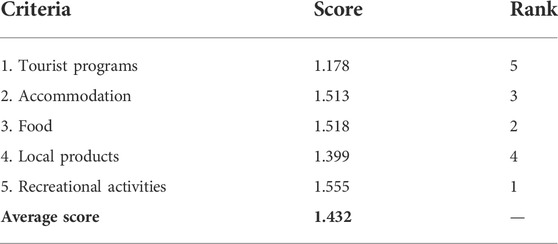
TABLE 6. Scores for the criteria on which the young tourists make the decision to spend their vacation in an ecotourism destination.
As other authors point out, the sustainable development of tourism requires the application of ecological thinking (Sima, 2017) in relation to all categories of tourism services.
3.3.7 Q6—what are the most famous ecotourism destinations in Romania?
The young people questioned in this survey know well the ecotourism destinations in Romania and the activity of the Romanian Ecotourism Association that promotes these destinations. According to young people, the most popular ecotourism destinations are Danube Delta (86.70%) and Mărginimea Sibiului (78.89%) (Figure 5).
Based on the score obtained using the semantic differential, the decreasing order of the top 10 ecotourism destinations in Romania, in the opinion of the young tourists surveyed, is as following: 1—the Danube Delta, 2—Marginimea Sibiului, and 3—Eco Maramures; these three zones achieved a score over the average one (3.549).
They are followed by 4—Tara Dornelor (Dorna Land), 5—Baile Tusnad (Tusnad Baths) and surroundings, 6—Tinutul Zimbrului (Bison land) Vanatori Neamt, 7—Transylvania Hills, 8—Zarnesti–Padurea Craiului (The forest of the King), 9—Cheile Nerei (Nera Gorge), and 10—Tara Hategului (Hateg Land)–Retezat (Table 7).
Our results show that the Danube Delta is the most famous ecotourism destination for young people. This one is part of the Dobrogea region, famous for other protected areas, such as Razim–Sinoe lagoon complex, Măcin Mountains National Park, and North Dobrogea Plateau (Thompson and Arowosafe, 2020). Similar to Thompson and Arowosafe (2020), at the local level, there is a need for good collaboration between the public and private sectors for the promotion and management of ecotourism destinations (Tisca et al., 2016). Tisca et al. (2016) emphasized the need to focus on service quality (Stoleriu et al., 2019). Stoleriu et al. (2019) reviewed the comments posted by tourists on Tripadvisor after visiting the Danube Delta, pointing out that the reviews relate to contact with nature and wildlife, their experiences being mostly passive, predominantly visual (Vinerean et al., 2021).
Hypothesis 2:. During the COVID 12 pandemic (2020–2021) young people visited local ecotourism destinations several times
3.3.8 Q7—what ecotourism/rural tourism destinations have you visited in 2020 and 2021 in Sibiu County?
During their undergraduate and/or master’s studies, students spend between 4 and 6 years in Sibiu County, and this offered them the opportunity to visit the most famous holiday destinations in the surroundings of Sibiu. The answers received regarding their visit in the last 2 years of the COVID-19 pandemic (Liu et al., 2021; Zhou et al., 2021; Ge et al., 2022; Mamirkulova and Mi, 2022) (Figure 6) show that, even during this period, the young people traveled. In a study published in 2021, Vinerean et al. (2021) reported a decrease in the number of tourists from Sibiu to 59.23% in 2020 compared to 2019 (Dumitras et al., 2017). The most visited tourist destinations by young people in the last 2 years were Păltiniș Resort (80.73%), Trasfăgărășanul (74.31%), Mărginimea Sibiului (72.94%), Bâlea Lac and Bâlea Cascadă (72.01%), and Transalpine (67.43%).
3.3.9 Q8—how many times have you visited the top 10 ecotourism destinations in Sibiu County?
The frequency of visits to the main ecotourism destinations in Sibiu County in the last 2 years is correlated with the answers received to the previous question. From Figure 7, it is observed that, in the years 2020 and 2021, the respondents most often visited these destinations 1–3 times: Trasfăgărășanul (51.83%), Bâlea Lac and Bâlea Waterfall (50%), and Mărginimea Sibiului (46.33%). With a frequency of 3–5 times of visits made by young people in ecotourism destinations in Sibiu County, Păltiniș Resort (25.22%), Transalpina (19.26%), and Transfăgărășan (18.88%) stand out. In the years 2020–2021, young people visited more than five times, especially Păltiniș Resort (22.93%), Ocna Sibiului (21.55%), and Mărginimea Sibiului (16.95%).
Among the ecotourism destinations that have never been visited in these 2 years are as follows: Podragu Lake (77.52%), the village of Biertan (62.84%), and Avrig Lake (57.79%). The average score for these 12 ecotourism destinations is 2.007.
Many of the ecotourism destinations existing in Sibiu County have been visited between 1 and 3 times by the questioned young tourists during the last 2 years, 2020 and 2021. From this point of view, the descending order of these destinations is the following one: 1—Transfagarasan, 2—Balea Lac (Balea Lake) and Balea Cascada (Balea Waterfall), 3—Castelul de Lut din Valea zanelor (Clay Castle from the Fairy Valley), 4—Transalpina, and 5—Paltinis Resort and Ocna Sibiului.
But there are numerous young tourists with an important share in total questioned group who have never visited other ecotourism destinations in Sibiu County including Podragul Lake, Biertan, Avrig Lake, and Fagaras Natural Park.
The ecotourism destinations visited over five times are the Paltinis Resort, which is advantaged because, during the summer season, it is pleasant temperature than in the city of Sibiu and in the winter season skiing could be successfully practiced, and also Ocna Sibiului, where the salted water is pleasant for relaxation and also for treatment.
Based on the obtained score for each ecotourism destination calculated by means of 4-Point Likert scale, the classification of these ecotourism destinations is the following one in the decreasing order: 1—Paltinis Resort, 2—Ocna Sibiului, 3—Marginimea Sibiului, 4—Transfagarasan, 5—Balea Lake and Balea Waterfall, 6—Transalpina, and 7—Cisnadioara. The rest of five destinations got smaller scores than the average score for all the 12 attractions (Table 8).
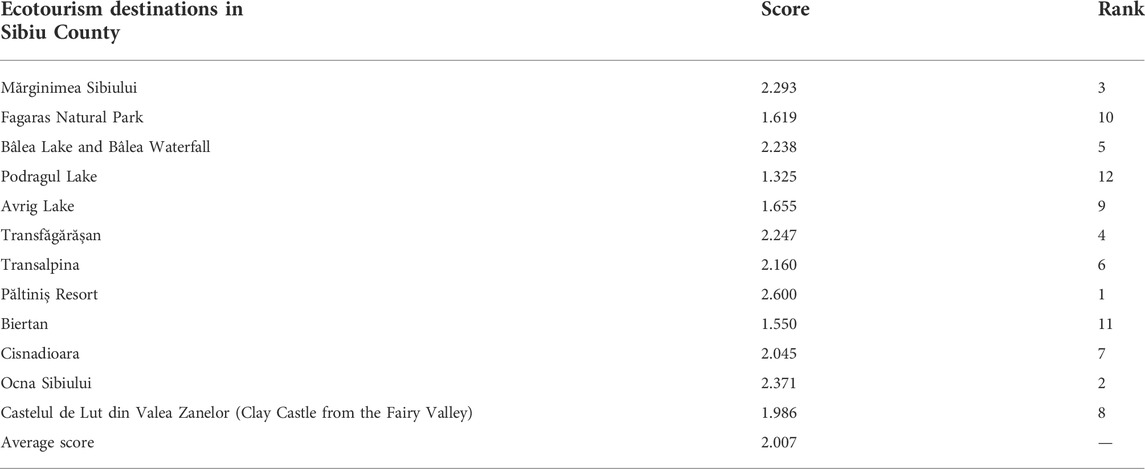
TABLE 8. Scores obtained for the visiting frequency of the ecotourism destinations in Sibiu County by young tourists.
3.3.10 Q9—how long was your last vacation spent in an ecotourism destination?
Regarding the length of a holiday spent in an ecotourism destination, most of the questioned persons, more exactly 74.77%, affirmed that it was between 1 and 3 days, meaning that weekends were frequently used for relaxation and activities in nature far away from the crowded cities. About 27.52% young tourists spent between 5 and 7 days, and only 4.59% had a vacation longer than 2 weeks (Figure 8). The results obtained are comparable to those reported by Dumitras et al. (2017), respectively, short-term vacations in protected areas nationwide (Singh, 2020). Singh (2020) pointed out that the tourism sector has been severely affected by the COVID-19 pandemic, with severe repercussions for the next 3–5 years. In this context, the author points out that exotic destinations in the natural and cultural world heritage will be less affected by the current situation. “Fast and exotic” or “quixotic tourism” has a chance to develop rapidly in the near future. The condition is to have adequate management and continuous monitoring, contributing to the support of local communities (Băltescu, 2021).
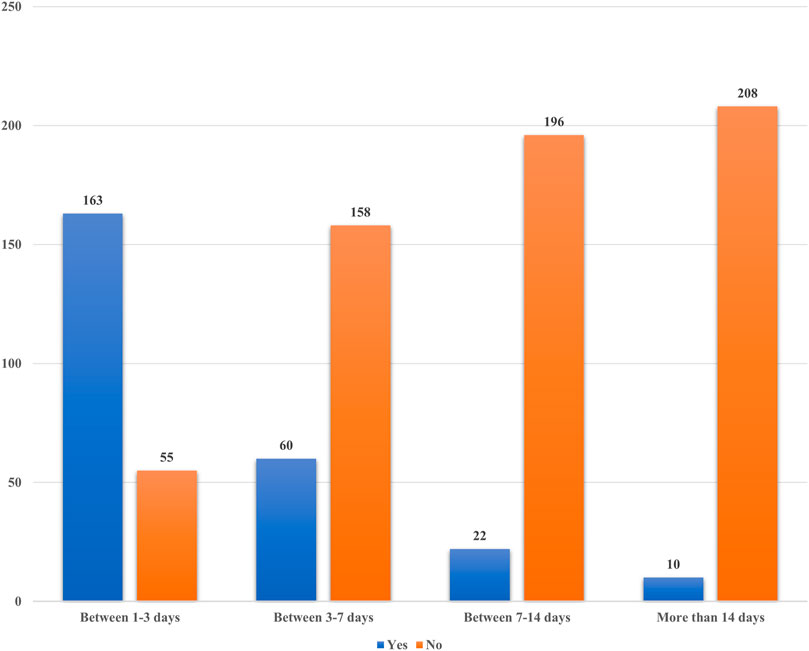
FIGURE 8. Duration of young people’s stay in ecotourism destinations in Sibiu County in 2020 and 2021.
3.3.11 Q10—what means of transportation did you use during your last vacation in an ecotourism destination?
Concerning the mean of transportation to the chosen ecotourism destination, 95.41% young tourists mentioned their own car because it allows arriving quickly and closer to the desired destination and more than this, during the COVID-19 pandemic, it was the safest alternative. They mainly use cars for transportation. Our results in terms of transport to holiday destinations show that young people behave less sustainably, which is also confirmed by Mejer et al. (2022) (10 Apps That You Should Not Miss When You Are in Nature, 2022).
On the second position was bicycle which was used by 25.23% of the questioned individuals who preferred this mean of transportation because they like a sporty lifestyle, and the bicycle is a tool to involve a physical effort and maintain health, at the same time, offering a joyful journey through isolated areas in the middle of nature. The train was used by 15.6% of the young tourists, the coach by 12.84%, and the van by 11.01%; the last two means of conveyance being less utilized due to the higher risk of infection during the pandemic (Figure 9).
Hypothesis 3:. Young people are accustomed to using the internet for information on various tourist services and use digital applications while traveling in nature
3.3.12 Q11—for what purpose did you use the digital media to plan your vacation in an ecotourism destination?
Young respondents are accustomed to using computerization to plan and conduct holidays in ecotourism destinations. Digitization is used by 91.28% of people (199) to book accommodation, 88.07% to search for holiday offers (192 people), 83.94% to book travel tickets (183 people), 74.31% to find out the weather forecast (162 people), 76.60% to offer a review for the quality of the tourist services provided (169 people), and 69.72% (152 people) for the purchase of access tickets to various tourist objectives.
Using the 5-Point Likert scale, the calculated scores for the purposes for which the digital media tools were utilized by the young tourists to plan their desired vacation in an ecotourism destination proved that the order of preference was the following one: 1—for booking accommodation, 2—for searching for holiday offers, and 3—for booking travel tickets, and these three options achieved a score higher than the average score accounting for 1.141 (Table 9).
Our results are in line with those obtained by Băltescu (2021), which points out that for the generation of millennials, the use of the Internet to search for various online resources and electronic devices is part of everyday life (Tlili et al., 2021), and the perception of trust and security influences their consumption intentions.
3.3.13 Q12—what mobile applications did you use during your holidays in nature?
Given the growing popularity of digitalization in all areas, we wanted to find out if young people are accustomed to use mobile applications during their holidays in nature. The Romanian Ecotourism Association recommends 10 mobile applications that can be used during nature hikes (Ganapathy et al., 2021). Approx. 40% (87 people) of young people often or always use digital maps, 19.72% (42 people) use the Mountain Rescue app, 14.22% (people) use the manual Offline Survivor app, and 14.22% (31 people) uses Net Plant, which helps them identify plants. The least used applications are My Lightning Tracker—identify lightning within a radius of 60 km (69.72%, 152 people) and Star Walk 2—identify star movement on the sky (69.72%, 152 people), which have never been used by young people surveyed (Table 10).
The importance given by the young tourists surveyed to mobile applications to be used in holidays in the middle of nature, according to the scores determined by means of the 5-Point Likert scale, was the following one: 1—ExpMapy, 2—Salvamont, and 3—PlantNet; all these three applications carrying out a higher score than the average one of 1.865.
The other mobile applications, in their descending order have been: 4—iTrackWildlife, 5—Offline Survival Manual, 6—Merlin BirdID, 7—Peak Finder, 8—Field Guides to Clouds, 9—Star Walk 2, and 10—My Lighting Tracker.
We found that the use of mobile applications during travel in nature is less used, which is also confirmed by the literature. There is very little evidence in the literature to show how smartphone apps can influence conservation behaviors and improve the connection between user and nature (Fernández-Ruano et al., 2022), while providing a good tourist experience (Aluculesei et al., 2021). Fernández-Ruano et al. (2022) pointed out that the integration of information and communication technologies (ICT) in ecotourism offers the possibility of interpreting the environment by including multimedia information brochures or even the integration of gamification (Dinu et al., 2021), as a tool that personalizes the tourist experience, making it more pleasant and interactive and contributing to the consolidation of the image of ecotourism destinations and its attractiveness. Pavlidis et al. (2022b) shows that there are more and more digital innovations in ecotourism, such as augmented reality mobile applications, digital maps, 3D/360° digitization, virtual reconstruction, and online flora recognition resources.
3.3.14 Q13—what were your sources of information to choose an ecotourism destination to spend your holiday?
The main sources of information for young people are (Figure 10) the Internet, 91.74% of respondents say it is their favorite source of information; 79.81% get information from friends or relatives; and 54.12% from radio/TV shows.

FIGURE 10. Sources of information-related samples Friedman’s two-way analysis of variance by ranks summary (N = 218; test statistics: 360.628; degree of freedom: 6).
The results are in line with the literature, which emphasizes that the Internet is an essential tool for segmenting the tourism market, allowing the provision of personalized services according to the needs and preferences of tourists.
At the same time, Dinu et al. (2021) points out that sociodemographic data and consumer behavior are major factors influencing the use of the internet in the accommodation booking system and tourism services.
The score obtained based on the application of the 5-Point Likert scale allowed to establish the hierarchy of the information sources used by the young tourists to plan their vacation in an ecotourism destination as follows: 1—Internet, 2—Relatives and friends, 3—Radio TV shows, 4—Tourism agencies, 5—Documentaries, 6—Leaflets and brochures, and 7—Newspapers and magazines. The average score was 0.582, which was exceeded only by the Internet and relatives and friends (Table 11).
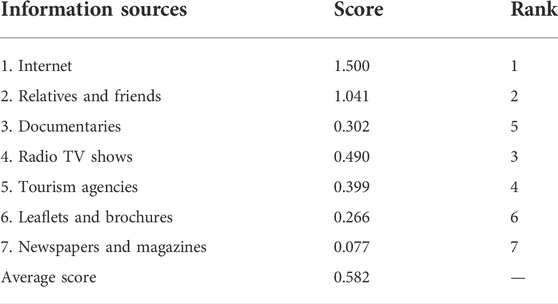
TABLE 11. Scores for information sources used by young tourists to plan their vacation in an ecotourism destination.
4 Conclusion
Ecotourism is an opportunity for the development of areas that have natural resources and conditions for their use, being an alternative for the integration of natural landscapes and biodiversity in tourism. The success of ecotourism destinations depends on the way in which the administrations of the protected areas manage to achieve a balance between natural and cultural resources and their capitalization. The sustainable use of natural and human resources within the perimeter of protected areas is an advantage for all parties involved in this process. In the future, those ecotourism business models will be successful in which entrepreneurs and the local community have an ecological attitude, and they want to share their knowledge and lifestyle with tourists, integrating environmental education into their current activity.
The aim of the study is to provide a perspective on following: the knowledge and perception of students in a faculty of agricultural profile and environmental protection regarding the ecotourism and the main ecotourism destinations in Romania; their behavior in visiting local ecotourism destinations in the last two years; and young people’s use of the internet for holiday planning and digital applications during nature trips.
After consulting the specialized literature, quantitative research was conducted based on a self-administered questionnaire, structured in 13 sections on ecotourism, to which were added the sociodemographic data of the respondents. The sample size was calculated using the formula proposed by Cohran E. The answers were synthesized and statistically processed. Frequency and distribution of answers obtained for each item were processed using the differential semantic scale and Likert scale with 4 and 5 points.
The results show that Hypothesis 1 is confirmed, respectively, young people know well the concept of ecotourism, its role in sustainable development, and the main ecotourism destinations in Romania. They believe that ecotourism has an educational character and respect for nature, takes place in nature, and is sustainable. In choosing an ecotourism destination, the most important is the beauty of the landscape, the multitude of activities that can take place in nature, and the hospitality of the hosts. Among the activities that young people want to carry out in protected areas are outdoor activities (hiking, biking, and sports activities), which must be harmoniously combined with activities related to knowing and experiencing local culture (tasting of local products, craft demonstrations, participation in local events, and local guided tours). For young people, the most popular ecotourism destinations in Romania are the Danube Delta and Mărginimea Sibiului.
The second hypothesis is also confirmed, namely, in the last 2 years of the COVID pandemic, 19 young people have visited most existing ecotourism destinations locally, with a visit frequency of 1–3 times and an average length of stay of 1–3 days. At the local level there are programs that encourage the population to participate in ecotourism activities and ecotourism fairs are organized.
The third hypothesis is also confirmed, internet access and digitization support the development of ecotourism, being used by young people especially for booking accommodation and looking for holiday offers. Mobile applications are used in nature for downloading digital maps, calling Mountain Rescue services, or recognizing plant species. The main sources of information are the internet, friends or relatives and radio/TV shows.
5 Theoretical and practical implications
The results of the study have theoretical and practical implications, emphasizing that young people have knowledge about ecotourism, which they perceive as a possible model for sustainable use of local tourism resources.
The main contribution to the specialized literature on ecotourism is related to the identification of the motivations for which young people choose an ecotourism destination and the main activities they would like to carry out in protected areas in Romania. The findings show that the image of the ecotourism destination has a major influence on the decision of potential ecotourists, and the identification of the activities that young people want to carry out are also useful for ecotourism destination managers.
6 Policy recommendations
The information obtained regarding the perception of potential young ecotourists on the attributes of an ecotourism destination shows that the image of all ecotourism destinations in Romania should be further promoted.
It is recommended to promote the locations of interest to young people on the media channels used by them. At the same time, it is important that the tourist package includes the services and activities that bring them maximum satisfaction, according to the questionnaire.
Data availability statement
The raw data supporting the conclusion of this article will be made available by the authors, without undue reservation.
Ethics statement
Ethical review and approval was not required for the study on human participants in accordance with the local legislation and institutional requirements. Written informed consent from the (patients/ participants OR patients/participants legal guardian/next of kin) was not required to participate in this study in accordance with the national legislation and the institutional requirements.
Author contributions
All authors have contributed to the study and writing of this research. MS and AP conceived the general idea of the research; MS and AP made the calculations of some indicators and realized the graphics; IB and GM carried out the investigation; and MS, AP, IB, CS, GM, JR, and BN made the interpretations of the data and drew the main conclusion. All authors have read and agreed to the published version of the manuscript.
Funding
This project was financed by the Lucian Blaga University of Sibiu and Hasso Plattner Foundation research grants LBUS-IRG-2021-07.
Conflict of interest
The authors declare that the research was conducted in the absence of any commercial or financial relationships that could be construed as a potential conflict of interest.
Publisher’s note
All claims expressed in this article are solely those of the authors and do not necessarily represent those of their affiliated organizations, or those of the publisher, the editors, and the reviewers. Any product that may be evaluated in this article, or claim that may be made by its manufacturer, is not guaranteed or endorsed by the publisher.
Supplementary material
The Supplementary Material for this article can be found online at: https://www.frontiersin.org/articles/10.3389/fenvs.2022.940957/full#supplementary-material
References
10 Apps That You Should Not Miss When You Are in Nature, (2022). 10 apps that you should not Miss when you are in nature. Available online: https://www.eco-romania.ro/en/pet-project/10-apps-that-you-should-not-miss-when-you-are-in-nature/ (accessed on June 25, 2022).
Abbas, J., Mahmood, S., Ali, H., Raza, M. A., Ali, G., Aman, J., et al. (2019). The effects of corporate social responsibility practices and environmental factors through a moderating role of social media marketing on sustainable performance of firms’ operating in multan, Pakistan. Sustainability 11, 3434. doi:10.3390/SU11123434
Abbas, J., Mubeen, R., Iorember, P. T., Raza, S., and Mamirkulova, G. (2021). Exploring the impact of COVID-19 on tourism: Transformational potential and implications for a sustainable recovery of the travel and leisure Industry. Curr. Res. Behav. Sci. 2, 100033. doi:10.1016/J.CRBEHA.2021.100033
Abbas, J., Raza, S., Nurunnabi, M., Minai, M. S., and Bano, S. (2019). The impact of entrepreneurial business networks on firms’ performance through a mediating role of dynamic capabilities. Sustainability 11, 3006. doi:10.3390/SU11113006
Abbasi, K. R., Adedoyin, F. F., Abbas, J., and Hussain, K. (2021). The impact of energy depletion and renewable energy on CO2 emissions in Thailand: Fresh evidence from the novel dynamic ARDL simulation. Renew. Energy 180, 1439–1450. doi:10.1016/J.RENENE.2021.08.078
Alfthan, B., Gjerdi, H., Puikkonen, L., Schoolmeester, T., Andresen, M., Gjerdi, H. L., et al. (2018). Mountain adaptation outlook series. Synthesis Report.
Aluculesei, A. C., Nistoreanu, P., Avram, D., and Nistoreanu, B. G. (2021). Past and future trends in medical spas: A Co-word analysis. Sustainability 13, 9646. doi:10.3390/SU13179646
Aman, J., Abbas, J., Shi, G., Ain, N. U., and Gu, L. (2021). Community wellbeing under China-Pakistan economic corridor: Role of social, economic, cultural, and educational factors in improving residents’ quality of life. Front. Psychol. 12, 816592. doi:10.3389/FPSYG.2021.816592
Asociația de Ecoturism din România Destinațiile de Ecoturism, 10 ani de Evoluție în România - descoperă eco-românia. Available online: https://www.eco-romania.ro/noutati-blog/destinatiile-de-ecoturism-10-ani-de-evolutie-in-romania/ (accessed on June 25, 2022).
Băltescu, C. A. (2021). Millennials’choices in applying digital techniques for tourism purposes. Proc. Int. Conf. Bus. Excell. 15, 257–267. doi:10.2478/PICBE-2021-0025
Bartlett, J. E., Kotrlik, J. W., and Higgins, C. C. (2001). Organizational research: Determining organizational research: Determining appropriate sample size in survey research appropriate sample size in survey research. Inf. Technol. Learn. Perform. J. 19.
Bilan, Y., Hussain, H., Haseeb, M., and Kot, S. (2020). Sustainability and economic performance: Role of organizational learning and innovation. Eng. Econ. 31, 93–103. doi:10.5755/j01.ee.31.1.24045
Bratu, M. L., and Ionel Cioca, L. (2019). “Impact of engineer personality on sustainable environment,” in Proceedings of 2019 international conference on ENERGY and ENVIRONMENT, 16–19. doi:10.1109/CIEM46456.2019.8937645CIEM
Buffa, F., Moscardo, G., and Rosen, M. A. (2015). Young tourists and sustainability. Profiles, attitudes, and implications for destination strategies. Sustainability 7, 14042–14062. doi:10.3390/SU71014042
Buric, M. N., Stojanovic, A. J., Filipovic, A. L., and Kascelan, L. (2022). Research of attitudes toward implementation of green accounting in tourism Industry in Montenegro-practices, and challenges. Sustainability 14, 1725. doi:10.3390/SU14031725
Celac, S., and Vădineanu, A. (2018). Strategia Naţională pentru dezvoltarea Durabilă a României 2030. Paideia: București. 978-606-748-261-4.
Charles Egerton Osgood, (1975). The measurement of meaning. Board of Trustees of the University of Illinois. 0 252 74539 6.
Cioca, L. I., and Bratu, M. L. (2020). Sustainability of youth careers in Romania—study on the correlation of students’ personal interests with the selected university field of study. Sustainability 13, 229. doi:10.3390/SU13010229
Cioca, L. I., and Bratu, M. L. (2021). Sustainable education in the context of COVID-19: Study of the social perception and well-being of students at the faculty of engineering in Sibiu, Romania. Sustainability 13, 12805. doi:10.3390/SU132212805
Cochran, W. G. (1977). Sampling techniques. Third edition. New York: John Wiley & Sons. 0 471 16240 x.
Coghlan, A., and Carter, L. (2020). Serious games as interpretive tools in complex natural tourist attractions. J. Hosp. Tour. Manag. 42, 258–265. Article in. doi:10.1016/j.jhtm.2020.01.010
Constantin, C. P., Papuc-Damașcan, V., Blumer, A., Albu, R. G., Suciu, T., Candrea, A. N., et al. (2021). Profiling visitors to Romanian ecotourism destinations. Sustainability 13, 2958. doi:10.3390/SU13052958
Country Facts, Eurostat. Available online: https://ec.europa.eu/eurostat/cache/countryfacts/# (accessed on June 25, 2022).
Crețu, C. R., Honțuș, A. C., Alecu, I. I., Smedescu, D., and Ștefan, P. (2020). Analysis of the ecotourist profile before the cOVID-19 crisis and post-crisis forecasts. Sci. Pap. Ser. Manag. Econ. Eng. Agric. Rural Dev., 20.
Dinu, V., Lazăr, S. P., and Pop, I. A.Babes-Bolyai University of Cluj-Napoca, Romania (2021). Factors that influence the adoption of the internet of things in tourism by Romanian consumers. Amfiteatru Econ. 23, 360. doi:10.24818/EA/2021/57/360
Dorobantu, M. R., and Nistoreanu, P. (2012). Rural tourism and ecotourism – The main priorities in sustainable development orientations of rural local communities in Romania. Econ. Transdiscipl. Cogn. 15, 259–266.
Dragomir, L., and Mazilu, M. (2021). Paradigms and paradoxes in the metamorphosis of ecotourism. Quaest. Geogr. 40, 71–84. doi:10.2478/QUAGEO-2021-0034
Drumeții Săptămânale Marca Anii Drumeției - Site-Ul Oficial al. Județului Sibiu Available online:(accessed on 25 June 2022) http://www.sibiu-turism.ro/Oferte-Speciale-Drumetii-saptamanale-marca-Anii-Drumetiei.aspx.
Dumitras, D. E., Muresan, I. C., Jitea, I. M., Mihai, V. C., Balazs, S. E., Iancu, T., et al. (2017). Assessing tourists’ preferences for recreational trips in national and natural parks as a premise for long-term sustainable management plans. Sustainability 9, 1596. doi:10.3390/SU9091596
Fernández-Ruano, M. L., Frías-Jamilena, D. M., Polo-Peña, A. I., and Peco-Torres, F. (2022). The use of gamification in environmental interpretation and its effect on customer-based destination brand equity: The moderating role of psychological distance. J. Destination Mark. Manag., 100677. doi:10.1016/J.JDMM.2021.100677
Franceschinis, C., Swait, J., Vij, A., and Thiene, M. (2021). Determinants of recreational activities choice in protected areas. Sustainability 14, 412. doi:10.3390/SU14010412
Fu, Q., Abbas, J., and Sultan, S. (2021). Reset the Industry redux through corporate social responsibility: The COVID-19 tourism impact on hospitality firms through business model innovation. Front. Psychol. 12, 6686.
Ganapathy, T., Othman, M. kamal, and Yahya, A. S. (2021). Incorporating heuristic evaluation (HE) in the evaluation of visual design of the eco-tourism smartphone app. J. Vis. Art Des. 13, 18–34. doi:10.5614/J.VAD.2021.13.1.2
Ge, T., Abbas, J., Ullah, R., Abbas, A., Sadiq, I., Zhang, R., et al. (2022). Women’s entrepreneurial contribution to family income: Innovative technologies promote females’ entrepreneurship amid COVID-19 crisis. Front. Psychol. 13, 828040. doi:10.3389/FPSYG.2022.828040
Georgescu, M. A., and Herman, E. (2020). Are young people ready to have a pro-environmental sustainable behaviour as tourists? An investigation of towel reuse intention. Sustainability 12, 9469. doi:10.3390/SU12229469
Gibson, A., Dodds, R., Joppe, M., and Jamieson, B. (2003). Ecotourism in the city? Toronto’s green tourism association. Int. J. Contemp. Hosp. Manag. 15, 324–327. doi:10.1108/09596110310488168
Halbusi, H., Al-Sulaiti, K., Abbas, J., and Al-Sulaiti, I. (2022). Assessing factors influencing technology adoption for online purchasing amid COVID-19 in Qatar: Moderating role of word of mouth. Front. Environ. Sci., 1039.
Hussain, T., Abbas, J., Wei, Z., Ahmad, S., Xuehao, B., Gaoli, Z., et al. (2021). Impact of urban village disamenity on neighboring residential properties: Empirical evidence from nanjing through hedonic pricing model appraisal. J. Urban Plan. Dev., 147. doi:10.1061/(ASCE)UP.1943-5444.0000645
Ibm, IBM SPSS Statistics 26. Available online: https://www.ibm.com/support/pages/downloading-ibm-spss-statistics-26 (accessed on June 24, 2022).
Li, X., Abbas, J., Dongling, W., Baig, N. U. A., and Zhang, R. (2022). From cultural tourism to social entrepreneurship: Role of social value creation for environmental sustainability. Front. Psychol. 13, 3261. doi:10.3389/fpsyg.2022.925768
Li, Z., Wang, D., Abbas, J., Hassan, S., and Mubeen, R. (2021). Tourists’ health risk threats amid COVID-19 era: Role of technology innovation, transformation, and recovery implications for sustainable tourism. Front. Psychol. 12, 769175. doi:10.3389/FPSYG.2021.769175
Liu, Q., Qu, X., Wang, D., Abbas, J., and Mubeen, R. (2021). Product market competition and firm performance: Business survival through innovation and entrepreneurial orientation amid COVID-19 financial crisis. Front. Psychol., 790923. doi:10.3389/FPSYG.2021.790923
Mamirkulova, G., and Mi, J. (2022). Economic corridor and tourism sustainability amid unpredictable COVID-19 challenges: Assessing community well-being in the world heritage sites. Front. Psychol., 12.
Mateoc-Sîrb, N., Albu, S., Rujescu, C., Ciolac, R., Țigan, E., Brînzan, O., et al. (2022). Sustainable tourism development in the protected areas of maramureș, Romania: Destinations with high authenticity. Sustainability 14, 1763. doi:10.3390/SU14031763
Milićević, S., Bošković, N., and Lakićević, M. (2021). Sustainable tourism development in mountain areas in šumadija and western Serbia. J. Mt. Sci. 18, 735–748. doi:10.1007/s11629-020-6239-4
Mitrică, B., Şerban, P. R., Mocanu, I., Damian, N., Grigorescu, I., Dumitraşcu, M., et al. (2021). Developing an indicator-based framework to measure sustainable tourism in Romania. A territorial approach. Sustainability 13, 2649. doi:10.3390/SU13052649
Mubeen, R., Han, D., Abbas, J., Álvarez-Otero, S., and Sial, M. S. (2021). The relationship between CEO duality and business firms’ performance: The moderating role of firm size and corporate social responsibility. Front. Psychol. 12, 669715. doi:10.3389/fpsyg.2021.669715
Mubeen, R., Han, D., Abbas, J., Raza, S., and Bodian, W. (2021). Examining the relationship between product market competition and Chinese firms performance: The mediating impact of capital structure and moderating influence of firm size. Front. Psychol. 0, 709678. doi:10.3389/FPSYG.2021.709678
Negacz, K. (2021). Distinction through ecotourism: Factors influencing sustainable consumer choices. Scand. J. Hosp. Tour. 21, 514–530. doi:10.1080/15022250.2021.1978860
Nicula, V., and Popsa, R. E.Lucian Blaga University of Sibiu, Romania (2018). Involvement of rural tourism operators in the project “Sibiu European gastronomic region. Amfiteatru Econ. 20, 951. doi:10.24818/EA/2018/S12/951
Nistoreanu, P., Aluculesei, A. C., and Avram, D. (2020). Is green marketing a label for ecotourism? The Romanian experience. Information 11, 389. doi:10.3390/INFO11080389
Pavlidis, G., Solomou, A., Stamouli, S., Papavassiliou, V., Kritsis, K., Kiourt, C., et al. (2022). Sustainable ecotourism through cutting-edge technologies. Sustainability 14, 800. doi:10.3390/SU14020800
Pavlidis, G., Solomou, A., Stamouli, S., Papavassiliou, V., Kritsis, K., Kiourt, C., et al. (2022). Sustainable ecotourism through cutting-edge technologies. Sustainability 1414, 800800. doi:10.3390/SU14020800
Petris, C. C., Ispas, A., and Candrea, A. N. (2022). Examining the relationships between visitors profile, satisfaction and revisit intentions: Evidence from Romanian ecotourism destinations. Land (Basel) 11, 186. doi:10.3390/LAND11020186
Pleșoianu, D.-M., Grecu, E., and Popescu, A. (2018). The heritage of traditions and tourism facilities in Transilvania, Romania. Sci. Pap. Ser. Manag. Econ. Eng. Agric. Rural Dev. 18.
Popescu, A., and Plesoianu, D.-M. (2021). Concentration of tourist arrivals in tourist and agri-tourist guesthouses in the cOVID-19 pandemic 2020 versus 2019 in Romania. Scientific Papers Series Management, Economic Engineering in Agriculture and Rural Development, 21.
Popescu, G., Popescu, C. A., Iancu, T., Brad, I., Peț, E., Adamov, T., et al. (2022). Sustainability through rural tourism in moieciu area-development analysis and future proposals. Sustainability 14, 4221. doi:10.3390/SU14074221
Probst, L. (2022). Higher education for sustainability: A critical review of the empirical evidence 2013-2020. Sustainability 14, 3402. doi:10.3390/su14063402
Remus, H., Ovidiu, T. M., and Puiu, N. (2009). Ecorom – indicators system proposal of quality certification in ecotourism. Amfiteatru Econ. J. 11, 330–338.
Šaparnienė, D., Mejerė, O., Raišutienė, J., Juknevičienė, V., and Rupulevičienė, R. (2022). Expression of behavior and attitudes toward sustainable tourism in the youth population: A search for statistical types. Sustainability 14, 473. doi:10.3390/SU14010473
Scheyvens, R., van der Watt, H., Cheer, J. M., Graci, S., and Dolezal, C. (2021). Tourism, empowerment and sustainable development: A new framework for analysis. Sustainability 13, 12606. doi:10.3390/SU132212606
Sima, E. EconStor (2017). Agrarian economy and rural development-realities and perspectives for Romania. 8th Edition. of the International Symposium, 161–166.Sustainable rural development through tourism activities in dobrugdea’s rural area
Singh, S. (2020). ‘Quixotic’ tourism? Safety, ease, and heritage in post-COVID world tourism. J. Herit. Tour. 16, 716–721. doi:10.1080/1743873X.2020.1835924
Soica, S. (2016). Tourism as practice of making meaning. Ann. Tour. Res. 61, 96–110. doi:10.1016/J.ANNALS.2016.09.003
Stanciu, M. (2014). in Scientific papers series management (Economic Engineering in Agriculture and Rural Development), 14.Analysis of touristic development potential of some Natura 2000 sites
Stoleriu, O. M., Brochado, A., Rusu, A., and Lupu, C. (2019). Analyses of visitors’ experiences in a natural world heritage site based on TripAdvisor reviews. Visit. Stud. 22, 192–212. doi:10.1080/10645578.2019.1665390
The Encyclopedia of Ecotourism, (2000). in The Encyclopedia of ecotourism. Editor D. Weaver (New York: CABI Publishing).
Thompson, O., and Arowosafe, C. F. (2020). Developing a public-private partnerships model for sustainable management of ecotourism sites in Nigeria. Sci. Pap. Ser. Manag. Econ. Eng. Agric. Rural Dev. 20, 527–538.
Tisca, A. I., Istrat, N., Dumitrescu, C. D., and Cornu, G. (2016). Management of sustainable development in ecotourism. Case study Romania. Procedia Econ. Finance 39, 427–432. doi:10.1016/S2212-5671(16)30344-6
Tlili, A., Altinay, F., Altinay, Z., and Zhang, Y. (2021). Envisioning the future of technology integration for accessible hospitality and tourism. Int. J. Contemp. Hosp. Manag. 33, 4460–4482. doi:10.1108/ijchm-03-2021-0321
Trišić, I., Štetić, S., Privitera, D., Petrović, M. D., Maksin, M., Vujović, S., et al. (2021). Perspectives on sustainable tourism development in the hotel industry—a case study from southern Europe. Sustainability 13, 5563. doi:10.3390/SU13105563
Tudorache, D. M., Timotin, V., Cârlogea, A. C., and Musteață-Pavel, M. (2016). Main strategic directions of ecotourism development in Romania. Knowl. Horizons - Econ. 8, 10–14.
Vidickienė, D., Gedminaite-Raudone, Z., Vilke, R., Chmielinski, P., and Zobena, A. (2021). Barriers to start and develop transformative ecotourism business. Eur. Countrys. 13, 734–749. doi:10.2478/euco-2021-0039
Vinerean, S., Opreana, A., Tileagă, C., and Popșa, R. E. (2021). The impact of COVID-19 pandemic on residents’ support for sustainable tourism development. Sustainability 13, 12541. doi:10.3390/SU132212541
What Is Ecotourism, (2022). What is ecotourism. Available online: https://ecotourism.org/what-is-ecotourism/(accessed on June 24, 2022).
Wojcieszak-Zbierska, M. M., Jęczmyk, A., Zawadka, J., and Uglis, J. (2020). Agritourism in the era of the coronavirus (COVID-19): A rapid assessment from Poland. Agriculture 10, 397. doi:10.3390/AGRICULTURE10090397
World tourism organization accessibility and inclusive tourism development in nature areas – compendium of best practices. UNWTO 2021, doi:10.18111/9789284422777
World Tourism Organization Affiliate Members Global Report, (2016). Volume 13 - the power of youth travel. UNWTO 58. doi:10.18111/9789284417162
World Tourism Organization Ecotourism and Protected Areas, (2022). World tourism organization ecotourism and protected areas. Available online: accessed on https://www.unwto.org/sustainable-development/ecotourism-and-protected-areas June2022 24.
Yu, S., Abbas, J., Draghici, A., Negulescu, O. H., and Ain, N. U. (2022). Social media application as a new paradigm for business communication: The role of COVID-19 knowledge, social distancing, and preventive attitudes. Front. Psychol. 13, 903082. doi:10.3389/FPSYG.2022.903082
Zhang, X., Husnain, M., Yang, H., Ullah, S., Abbas, J., Zhang, R., et al. (2022). Corporate business strategy and tax avoidance culture: Moderating role of gender diversity in an emerging economy. Front. Psychol. 13, 827553. doi:10.3389/FPSYG.2022.827553
Keywords: ecotourism behavior, sustainability, youth perception, attitude, knowledge, activities, digital technology
Citation: Stanciu M, Popescu A, Sava C, Moise G, Nistoreanu BG, Rodzik J and Bratu IA (2022) Youth’s perception toward ecotourism as a possible model for sustainable use of local tourism resources. Front. Environ. Sci. 10:940957. doi: 10.3389/fenvs.2022.940957
Received: 16 May 2022; Accepted: 11 July 2022;
Published: 12 August 2022.
Edited by:
Bibhya Sharma, University of the South Pacific, FijiReviewed by:
Krishan Kumar, University of the South Pacific, FijiJ. Abbas, Shanghai Jiao Tong University, China
Copyright © 2022 Stanciu, Popescu, Sava, Moise, Nistoreanu, Rodzik and Bratu. This is an open-access article distributed under the terms of the Creative Commons Attribution License (CC BY). The use, distribution or reproduction in other forums is permitted, provided the original author(s) and the copyright owner(s) are credited and that the original publication in this journal is cited, in accordance with accepted academic practice. No use, distribution or reproduction is permitted which does not comply with these terms.
*Correspondence: Iulian Alexandru Bratu, iulian.bratu@ulbsibiu.ro
†These authors have contributed equally to this work
 Mirela Stanciu
Mirela Stanciu